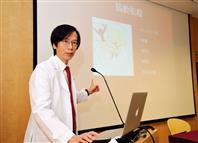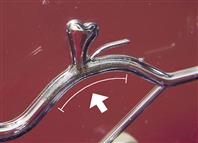Cerebral aneurysm is a serious potential health hazard that occurs in about 2–6% of the population in Hong Kong. It is thought to be associated with hypertension, atherosclerosis, and congenital factors leading to vessel wall weakening. Aneurysm rupture (when a blood vessel in the brain breaks) is a cause of intracranial bleeding that may lead to severe disability, comatose or even death (the death rate is as high as 45%). The risk of rupture of an aneurysm is about 1.3% per year, remote but sufficiently alarming to one who lives with it. In the overall population, the incidence of aneurysm rupture is 10.5 per 100,000 people.
Conventionally, cerebral aneurysms are treated by clipping their necks but the open brain surgery involved presents great risk. Endovascular coil embolization is a less invasive approach but its feasibility is limited by the fusiform morphology of the aneurysm. For large-sized aneurysms that have incorporated the parent vessel or aneurysms with wide necks, stent assisted coiling is necessary to keep the coils in place. Even so, the recurrence rates of aneurysms could be as high as 17% for coil embolization and 15% for stent-assisted coiling.
The Vascular and Interventional Radiology Foundation Clinical Science Centre at CUHK has successfully conducted Asia’s first clinical research with seven medical centres in Hong Kong on the use of ‘flow diverters’ (pipeline) in treating cerebral aneurysms. Under the leadership of Prof. Yu Chun-ho Simon, the Centre’s director and professor at the Department of Imaging and Interventional Radiology at CUHK, the study discovered that flow diverter (pipeline) is a safe and effective approach to treating cerebral aneurysms.
Pipeline embolization device placement is a technological breakthrough in the treatment of cerebral aneurysms. A flow diverter is a tube-like device composed of tightly knitted fine metal strips, to be implanted in the vascular segment affected by the aneurysm using percutaneous endovascular methods. After placement of the flow diverter, blood flow is diverted away from the aneurysm so that, with blood traffic stopped, the aneurysm eventually regresses. The device works equally well with different sizes or morphologies of the aneurysm, and it does not affect adjacent blood vessels.
Professor Yu said, ‘The fact that the concept of flow diverter (pipeline) is proved effective for cerebral aneurysms among Asians is wonderful news to me as a doctor, because we now have a reliable device that can be used safely for treating our patients with aneurysms. The vascular segment harbouring the aneurysm is basically reconstructed into a new vessel as the surface of the device is completely covered with a new layer of endothelium and becomes incorporated into the vessel. To me the technology of flow diverter (pipeline) is almost a perfect solution for aneurysms.’
The clinical study was conducted from September 2008 to September 2011, involving 143 patients and 178 aneurysms. In this study, the flow diverter was found to be a safe and effective treatment for aneurysms with unfavourable morphological features such as wide neck, large size, fusiform morphology, incorporation of side branches, and post-treatment recanalization. Although it takes time for the aneurysms treated with flow diverters to become completely occluded, recurrence of these occluded aneurysms is virtually unheard of. Occlusion or stenosis of the parent artery after placement of flow diverters is extremely rare.
CUHK recommends the flow diverter (pipeline) as a preferred treatment for unruptured aneurysms and recurrent aneurysms. The results of the study were published in the journal Radiology in December 2012. If cerebral aneurysms could be found out before they rupture and treated with flow diverter (pipeline), hundreds of lives could be saved in Hong Kong a year. Professor Yu said, 'The technology can be further improved if the device is made of material that could enhance endothelialization and therefore shorten the time required for complete aneurysm occlusion, and that could also be decomposed and absorbed after the device is completely endothelialized.' 



































































































































































Social Bookmarks